Name USS Guardian Commissioned 16 December 1989 Struck 15 February 2013 Launched 20 June 1987 Beam 12 m | Laid down 8 May 1985 Decommissioned 15 February 2013 Construction started 8 May 1985 Length 68 m Builder Peterson Builders | |
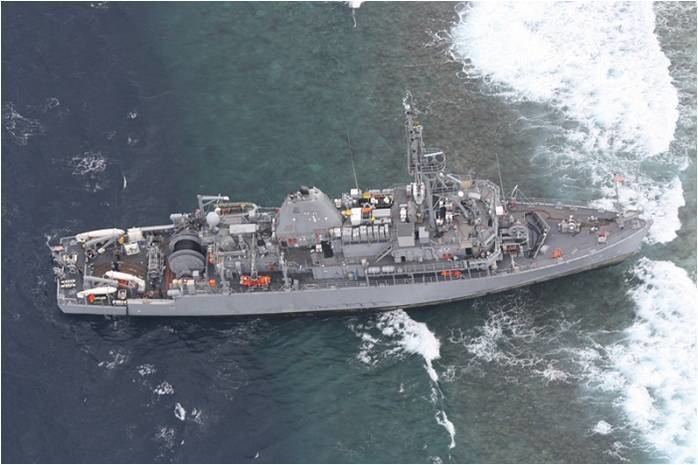 | ||
Motto "Forerunner of Freedom" | ||
Us navy mine sweeping uss guardian mcm 5 blows up mine off thailand coast
USS Guardian (MCM-5) was an Avenger-class mine countermeasures ship of the United States Navy. The second ship to bear that name, she was laid down on 8 May 1985 by Peterson Builders, Sturgeon Bay, Wisconsin; launched on 20 June 1987; and commissioned on 16 December 1989. In 2010, Guardian became the first mine countermeasures vessel in the Seventh Fleet modified for a mixed-sex crew.
Contents
- Us navy mine sweeping uss guardian mcm 5 blows up mine off thailand coast
- History
- January 2013 grounding
- Chart error
- Awards
- References
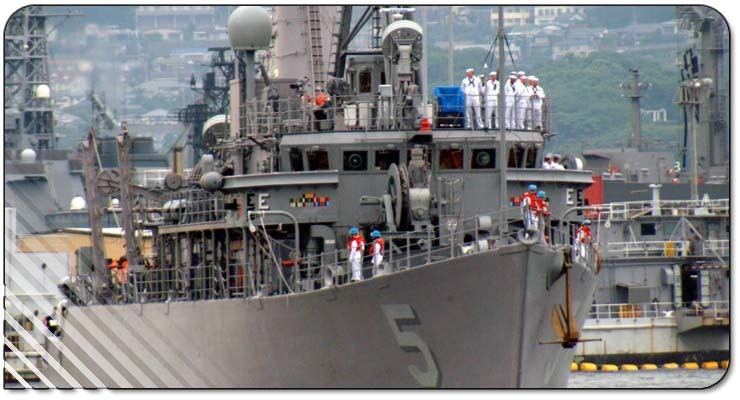
On 17 January 2013, Guardian ran aground on Tubbataha Reef. Unable to be recovered, the vessel was decommissioned and struck on 15 February 2013. After the removal of fuel and useful equipment, the minehunter was cut into three sections and lifted off the reef by crane ships. The last section was removed from Tubbataha Reef on 30 March 2013.
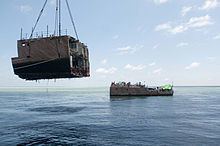
Us navy mine sweeping uss guardian mcm 5 blows up mine off thailand coast
History
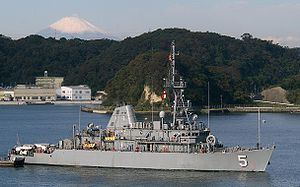
In late November 2007, USS Guardian and fellow minesweeper USS Patriot sought refueling and refuge from an approaching storm in Hong Kong's Victoria Harbour, but were denied entry without explanation by the People's Republic of China. Both ships were eventually refueled at sea and returned safely to their homeports in Japan.
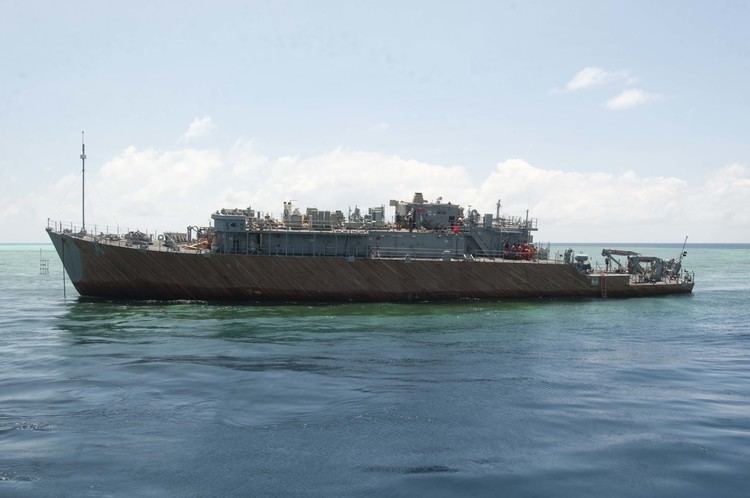
In February 2010, USS Guardian became the first mine countermeasures vessel in the Seventh Fleet to receive the Women-at-Sea modification, which was intended to allow the small vessel to accommodate a mixed-gender crew. The modification added no additional sleeping space, but did provide for separate toilet and shower facilities for female crew members. However, with the exception of a very few officers, all mine countermeasures vessels in the Seventh Fleet were still manned by all-male crews at that time.
January 2013 grounding
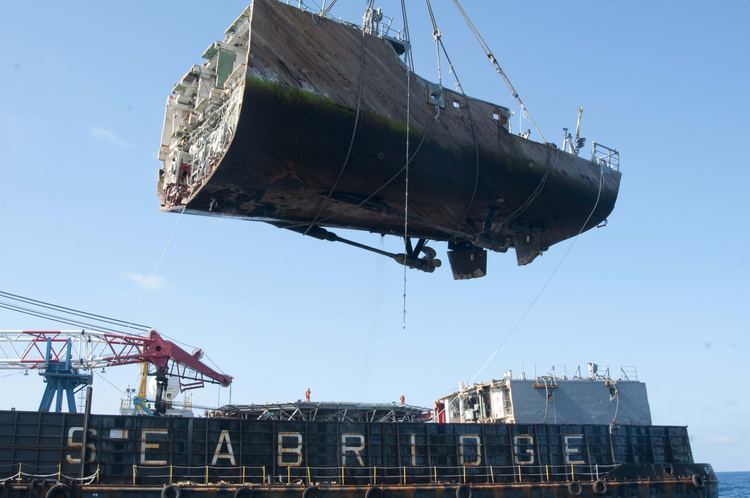
On 17 January 2013, following a port call and fuel stop in Subic, Guardian proceeded across the Sulu Sea and entered the Tubbataha Reefs Natural Park where she grounded at 2:25 am. About 90 minutes after the grounding she was seen on park radar, at approximately 04:00 hours local time. Guardian ran aground on Tubbataha Reef about 130 kilometres (70 nmi) south east of Palawan in the Philippines. At the time of the accident the ship was travelling from Subic Bay in the Philippines to Indonesia. The extent of any damage to the reef was unknown, but there was no evidence that there was a fuel oil leak. Philippines officials later estimated the damage to the reef at 1,000 square meters. The U.S. Navy evacuated all 79 crew members from the minesweeper to USNS Bowditch and MV C Champion on 18 January. In recognition of his actions in evacuating the sailors aboard Guardian, Petty Officer Travis Kirckof, a mineman aboard USS Guardian and one of the two assigned Search and Rescue swimmers, was awarded the Navy and Marine Corps Medal on 11 April 2014. Petty Officer Kirckof stayed in the shark-filled water for almost five hours to assist his shipmates in the evacuation to the nearby reef, saving at least two lives. On 19 January, an assessment team was deployed to plan and execute the vessel's extraction. On 20 January 2013, Navy Times reported the ship was taking on water in multiple places and was experiencing a slight list to port.
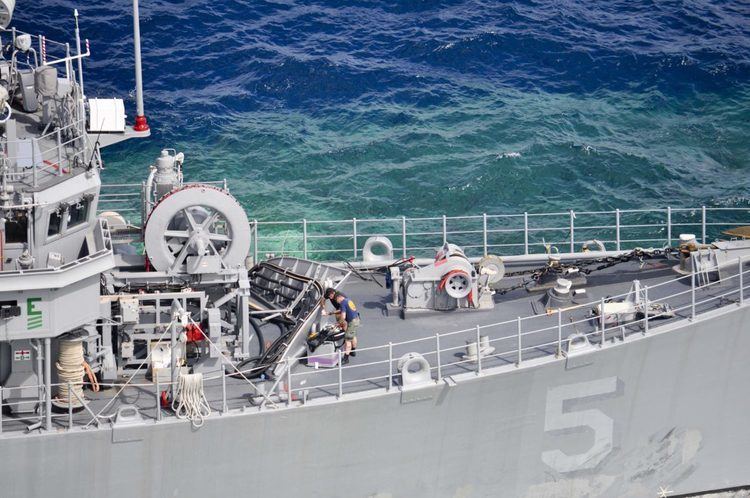
Originally, only the bow section of Guardian rested on the reef, but wave action pushed the entire vessel onto the reef, 20 to 30 metres (66 to 98 ft) from the edge. The guided missile destroyer USS Mustin, the oceanographic survey ship USNS Bowditch and the rescue and salvage ship USNS Salvor arrived in the area to help in the intended extraction, as well as tugboats and Philippine navy and coast guard vessels. It was intended for Guardian to be removed from the area by crane ships from Singapore and then be placed on a barge or other ship, since the ship was too damaged to be towed due to multiple hull penetrations. During the time that the cranes made their journey from Singapore to the Philippines, preparations were made for the lift. 15,000 gallons of diesel fuel were extracted from the tanks in Guardian to other ships that were on station and refilled with seawater to keep the vessel stable. Dry food stores and the personal effects of Guardian's crew were removed as well. Salvage experts began to reinforce the wood-and-fiberglass hull of the minesweeper with Kevlar lines to mitigate stresses from waves hitting the vessel. Salvage experts from Mobile Diving and Salvage Unit One and Smit Salvage then systematically cut the superstructure and hull of the ship into pieces that were lifted off of the reef. In February 2013, Guardian was replaced with USS Warrior in the 7th Fleet, with the crew of Warrior returning to San Diego, and the crew of Guardian taking over.
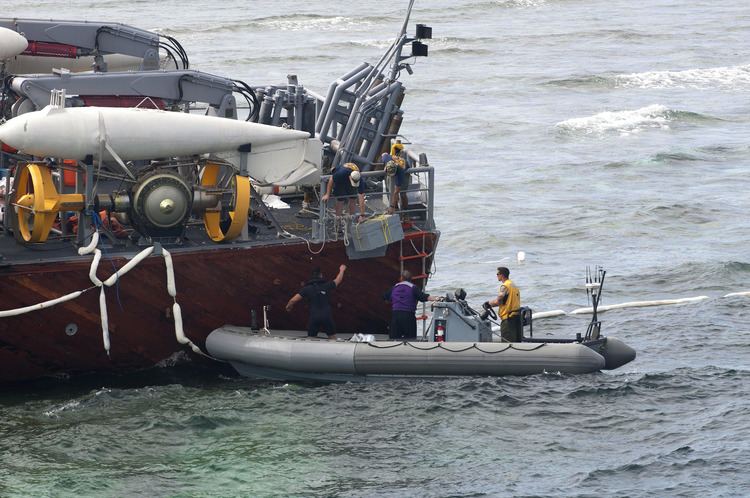
On 29 January 2013, the United States Navy announced that the ship would be cut into three sections on the reef prior to removal, resulting in the total loss of the ship. USS Guardian was decommissioned and struck from the Naval Vessel Register on 15 February 2013. On 27 February 2013, salvage crews began to disassemble Guardian, a process originally estimated to take a month. The bridge deck was removed on 4 March 2013. On 30 March 2013, the stern section of the ship was lifted off the reef, completing the removal process.
On 8 April 2013 it was reported that the U.S. Navy had turned over digital navigation charts and other relevant documents and data of Guardian to the Philippine Maritime Casualty Investigating Team (MCIT) and responded to various "technical and substantive" queries. The MCIT will conduct its own independent investigation and make recommendations about how to avoid such incidents in the future. On 26 July 2013 it was reported that a chart produced by the National Geospatial-Intelligence Agency was inaccurate by up to 8 nautical miles (15 km; 9.2 mi). This chart was used by the crew of the Guardian, and played a significant role in the grounding. However, significant errors by the crew and commanding officers were also reported, including that they should have noted the inaccuracies in comparison to other charts.
Original estimates were that 4,000 square metres (43,000 sq ft) of reef was damaged but a survey done after removal, by the World Wide Fund for Nature–Philippines and the Tubbataha Management Office, measured the damage area at 2,345.67 square metres (25,248.6 sq ft). On January 20, 2015, the United States Government paid to the Philippine government a total of 87 million Philippine pesos, or US$1.97 million – 59 million Philippine pesos for the damage and another 29 million pesos to reimburse for services provided by the Philippine Coast Guard.
The U.S. Federal Government apologized for the incident and relieved four officers: LCDR Mark Rice, Commanding Officer; LT Daniel Tyler, Executive Officer; the Lieutenant (j.g.) who was Officer of the Deck; and a QMC who was Assistant Navigator and Quartermaster of the Watch at the time of the mishap. "The initial investigation findings clearly indicate that (the four) at the time of the grounding did not adhere to standard US Navy navigation procedures," the Manila Bulletin quoted the U.S. Navy as saying. The U.S. Government has acknowledged that the grounding was entirely preventable and caused by human error and a failure of leadership to provide adequate oversight and direction in planning and executing the Navigation Plan.
Chart error
The National Geospatial Intelligence Agency (NGA) admitted the chart supplied to USS Guardian was flawed due to human error on the part of the NGA. This was an error that mislocated the Tubbataha Reef by 7.8 nautical miles (14.4 km; 9.0 mi). NGA was aware of this error in 2011 and updated a smaller scale electronic chart. NGA failed to publish a correction for the larger scale chart that the USS Guardian was using when she ran aground.
